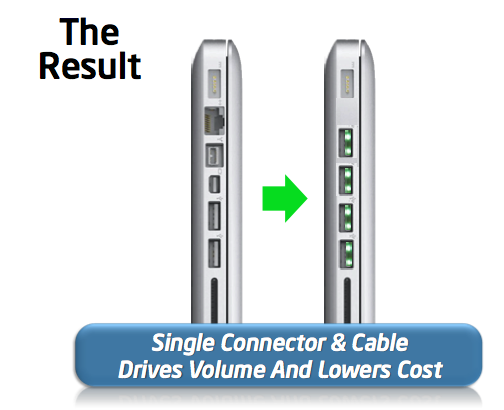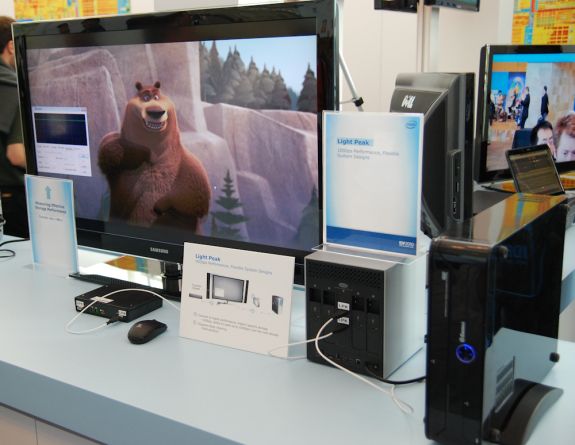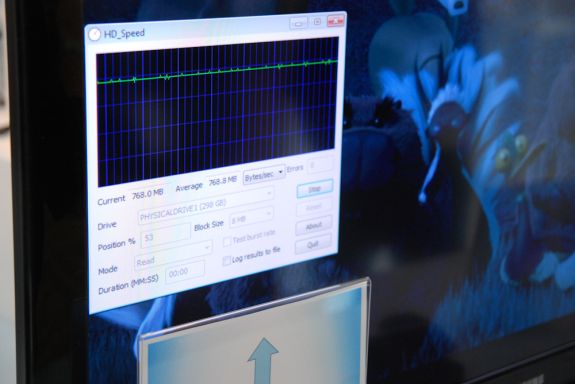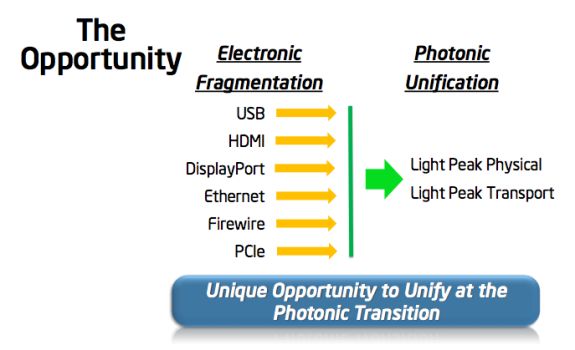Intel Light Peak - Lighting up 10 Gbps links in 2011
by Brian Klug on September 16, 2010 3:40 PM EST- Posted in
- Trade Shows
- Intel
- LightPeak
The second demo involved a desktop PC with Light Peak connecting to a modified LaCie 4big Quadra, daisy chained to another display with a built in HDMI adapter. Note that Light Peak supports daisy chaining as this demo was connected, but also supports a star topology like USB does.
At the far left on the TV was the total bitrate of the storage system, which showed a solid 768.8 megabytes/s of throughput. That's 6.15 gigabits per second of throughput. Obviously the video must have been uncompressed to achieve such high bitrate, but the display itself was only 1080P.
Both of these demos really show how close Intel is to finalizing Light Peak for consumer consumption, and how closely they've been working with partners like Western Digital and Avid for having devices ready eventually.
Obviously USB will live on for years, and USB 3.0 still isn't completely ubiquitous, but the allure of using a single connection and cable for everything sometime in the future is hard to pass up.
The Tech
I spoke with Jason Ziller - Intel's director of Optical I/O planning - about what's left for Light Peak before we can all start enjoying one superfast desktop connection. Availability was originally slated to be Q4 2010, that date has now slipped to sometime inside 2011.

Remember that USB-like port? It actually is USB, but that's only for ease of testing until Light Peak's new connector is finalized. The connector won't look like USB, and obviously will have something unique to mitigate both alignment and potential damage to the interface. Intel isn't ready to say what this looks like, but obviously the connector will be subject to the same kind of scrutiny that USB was for durability and consumer friendliness.
Light Peak isn't a protocol, but instead simply provides a new physical layer for existing connector protocols. Traffic like DVI-D, HDMI, USB, and audio can all coexist across Light Peak.
Intel didn't need to use WDM (Wavelength Division Multiplexing) to achieve 10 Gbps as demonstrated, and maintains that although WDM could be used in the future to increase bandwidth, there are other ways to scale to 100 Gbps. Currently Light Peak is 100 meters capable, though the actual product will be 50 meters of distance. Cables have sufficiently small bend radius that they can be wrapped in a knot or around a pencil without the connection losing connectivity, and up to 7 devices can be daisy chained.
Interestingly, Intel is using an 850 nm wavelength laser for the system, and (unsurprisingly) multimode fiber. Data is bidirectional across the interface as well. 850 nm is a rather interesting choice, as it's still subject to class 1 eye safety limits (just above -4 dBm), but moreso because it was the wavelength used in some of the world's very first long haul fiber optic networks.
Intel's silicon photonics remain a separate project from Light Peak, as Light Peak uses VCSEL laser diodes. The long term vision is to eventually bring the two together in a much broader scope to bridge datacenters together instead of just desktops.
There's a lot of potential for the future of desktop optical interfaces - Intel just has to deliver them. Let's hope it happens in 2011 as promised!













59 Comments
View All Comments
Jaybus - Friday, September 17, 2010 - link
The first generation LP will have competition from USB 3. For one thing, USB 3 is instantly backward compatible with the huge installed base of existing USB 2 devices. LP would need some sort of adapter and AFAIK doesn't provide power. So USB 3 will be much cheaper and at 10x the USB 2 bandwidth will seem "fast enough" for a few years.The big question, right now, is not Intel working LP into a chipset, or even into a SoC, but rather what about the device interface chip? Can drive makers selling $80 USB drives add a LP interface, or does that make the $80 drive a $120 drive? The USB 3 will already transfer data far faster than the drive can keep up with. The LP device interface chip has to be cost cometitive with the USB 3 chip.
However, I see the big move coming. When their integrated photonics stuff gets rolling, the cost of LP will dramatically fall. There is no question that the LP bandwidth has much room for growth, while any copper cabling system has near zero room for growth. Optical transmission is definitely the future, but the cost has to come down and something has to be done about supplying power for external devices.
wwwcd - Friday, September 17, 2010 - link
M$ not have possibilities to make a world size standart of comunication , if they come out of full support of the other biggest trademark in this industry!FXi - Friday, September 17, 2010 - link
Fails to deliver power over the connection. Thus ultimately it is about 1/10th as useful to the general population who will vote for simplicity over speed. USB 3 gives you both speed and power and will be multiples more useful.Pwnx0r - Friday, September 17, 2010 - link
There's going to be a copper wire in the cable for power.boden - Saturday, September 18, 2010 - link
One cable to rule them all,One cable to find them,
One cable to bring them all
and in the light, bind them.
Casper42 - Saturday, September 18, 2010 - link
If they can keep this stuff relatively cheap, the 50m Distance along with the ability to Daisy chain for longer distances means this would make a pretty decent Home Networking medium.How would you like to have 10GE strung around your entire house?
Or for that matter, take your HDD out of your desktop and have it in the basement.
Or hell, LPK enabled Monitor and leave the entire PC in the basement.
Can't wait to see what level they take this to and I pray they keep it fairly cheap.
ABR - Monday, September 20, 2010 - link
"obviously the connector will be subject to the same kind of scrutiny that USB was for durability and consumer friendliness"I hope not! While definitely nicer than old-style long-pin connectors, trying to plug a USB connector in without squinting at it and the plug fails half the time due to being upside down. Hope they can take a clue from Firewire-400 here.
bobbozzo - Monday, September 20, 2010 - link
One thing I haven't seen mentioned is if LP controllers will use DMA... this would be a big advantage over USB.Bob
Hrel - Wednesday, September 29, 2010 - link
"but the display itself was only 1080p"? WTF? You guys are really starting to piss me off. Resolutions over 1080p are useless for most people, many people still don't even have 1080p on all their screens. Also, I see almost no point in going to 1440p or 1600p, it's not going to be enough to make a noticeable difference; diminishing returns and all. Let the world catch up to 1080p, then, sometime around 2020, we can start getting excited about 16,160X9,090 ie 9090p or whatever becomes the next big step. Quite frankly 4320p isn't enough to convince me to spend any extra money, I'd still wait for a 37" to drop down under 500 bucks. 3D and stupid widgets I'll never use and all. /rant.